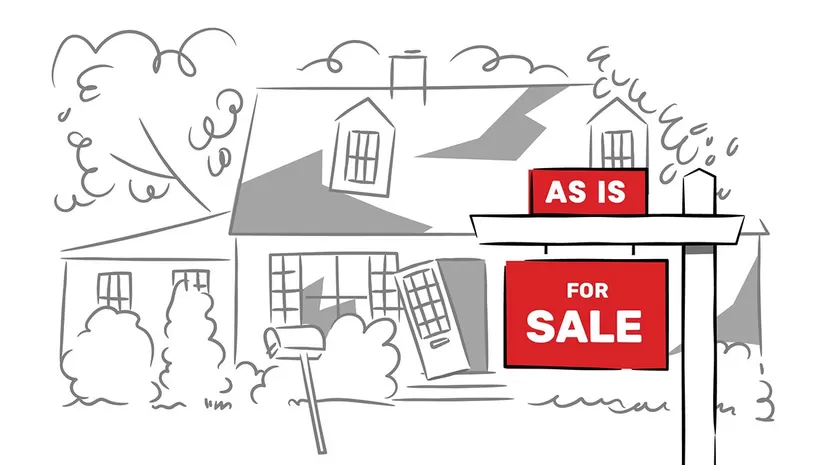By Larissa Runkle
Apr 28, 2022

If you’re shopping in today’s uber-competitive housing market, you’ve likely seen homes listed as is for sale. And while you should approach any house being sold under this term with caution, buying a home as is doesn’t necessarily mean you’re getting a bad deal.
At its most basic, a home being sold as is typically means the seller isn’t interested in any sort of negotiation. This might be because the seller wants to move quickly or doesn’t want to deal with the hassle of making minor cosmetic repairs.
The real problem for buyers is when there’s more to the story—like a structural flaw with the home or hidden damage that can cost a small fortune to repair. So how can you decipher a run-of-the-mill as-is deal from a seller looking to hide something significant? Here are seven red flags to watch for if you’re considering a home being sold as is.
1. Faulty foundation

Cracks in a foundation are never a good thing. So if an as-is home on your list winds up proving worse for the wear at the foundation level, then it might be time to reconsider.
“Cracks in the foundation could indicate a significant structural problem,” says real estate agent Neil Goradia, of Market Street Realty in Indianapolis. “Structural problems can quickly run into the tens of thousands of dollars.”
How to check it out: Have a licensed home inspector or experienced real estate agent do a walk-through with you to determine if an as-is home has any notable foundation issues. If there are, have a structural engineer create a damage report and then have several contractors bid on the repair. Once you know how much a repair will cost, reduce your offer by this amount to ensure you can get the house without overpaying.
2. Sketchy addition

Another structural problem you don’t want to ignore? A badly built addition.
“Homes with additions can typically have problems that are very expensive to resolve,” says real estate developer Bill Samuel, of Blue Ladder Development. “Ask the seller if the home has any additions and if the addition was permitted. I’d also generally discourage inexperienced buyers from purchasing as-is homes with additions.”
How to check it out: Work with a home inspector to check for any additions with flaws or shortcuts in the construction.
3. Roof damage

If you encounter an as-is home, you’ll want to make sure the reason isn’t a damaged roof.
“The cost of a roof replacement is estimated to be $8,000 plus, which is a high added cost on top of the home value, not to mention a major overhaul to the property,” says Joshua Blackburn, director of design and construction at Evolving Home. “Be on the lookout for any visible damages on the roof of the house you are checking because this is a big red flag.”
How to check it out: Be sure to eyeball the roof (from a safe distance on the ground) for any looming signs of damage. Also, take a peek in the attic to check out the roof from within the house.
4. Flood zone property

Before you make an offer on an as-is waterfront home, you’ll want to be sure it’s not in a flood zone since repairing past, or future, damage could be financially crippling.
“If a home is in a flood zone, that’s a red flag as it could mean major damage to the property,” says Scott Berens, owner of California’s Balsamo Homes.
Ask the sellers if the home has ever flooded before and if they can share details on the completed repairs.
How to check it out: Find out your home’s potential for damage with the Realtor.com® flood risk rating. And work with your local insurance agent to determine the cost of insuring the house, as flood insurance is costly.
5. Mold infestation

Like water damage, mold can be another nasty (and often hidden) element you won’t want to deal with in any property.
“Another challenging issue with as-is sales is the presence of mold problems,” says Bill Gassett, founder of Maximum Real Estate Exposure. “Mold is not only costly to remove, but it can also be a health hazard. As a result, most lenders will also want to steer clear of lending on a home that has a severe mold infestation.”
How to check it out: Be wary of any mildew smells or discoloration in the home’s walls, ceiling, or floors. If you suspect mold, talk with your real estate agent about having a mold professional inspect the house.
6. Septic system failure

Something else that might be lurking underground (literally) in an as-is home is a failing septic system.
“In the case of a failed septic system, most lenders will not grant a mortgage without proper replacement,” says Gassett. “Adding a new septic system can carry high costs and an extreme pricing variability level. For example, you might spend $10,000 on replacement or upward of $50,000.”
How to check it out: While a septic issue can be hard to detect, some apparent signs of septic system failure include a foul-smelling or soggy leach field. Be sure to inquire about the age of the septic system and review the seller’s disclosure statement for any history of septic issues.
7. Not allowing an inspection

While it’s worth your time to investigate any and all issues that come up during the process of buying a house as is, one red flag that takes the cake is when a seller denies the buyer an inspection.
“’As is’ simply means no renegotiating the sales price, and that’s fine in a competitive … market,” says Chase Michels of Illinois’ The Michels Group. “But I advise my clients against moving forward with any home if the owners will not allow an inspection. Buyers have a right to know the condition of the home they’re buying. And if sellers disagree, it tends to mean they’re hiding something.”
How to check it out: Unless you love the home, this red flag usually means you should walk away from the deal. Talk to your real estate agent first and try to come up with a solution both parties are comfortable with. If you can’t meet in the middle, pass on the home. Remember—you’ll be buying all of its problems as well as its charm.
Source- https://www.realtor.com/advice/buy/buying-a-home-as-is-red-flags-to-watch-for/






